
Responsive Delivery: Effective Practices for Digital First Organizations
Digital first organizations are creating experiences that are addressing an unprecedented amount of design challenges across a rapidly changing set of platforms and channels. This increasing degree of uncertainty requires that these organizations develop a responsive delivery approach to foster collaboration between marketing and its technology partners.
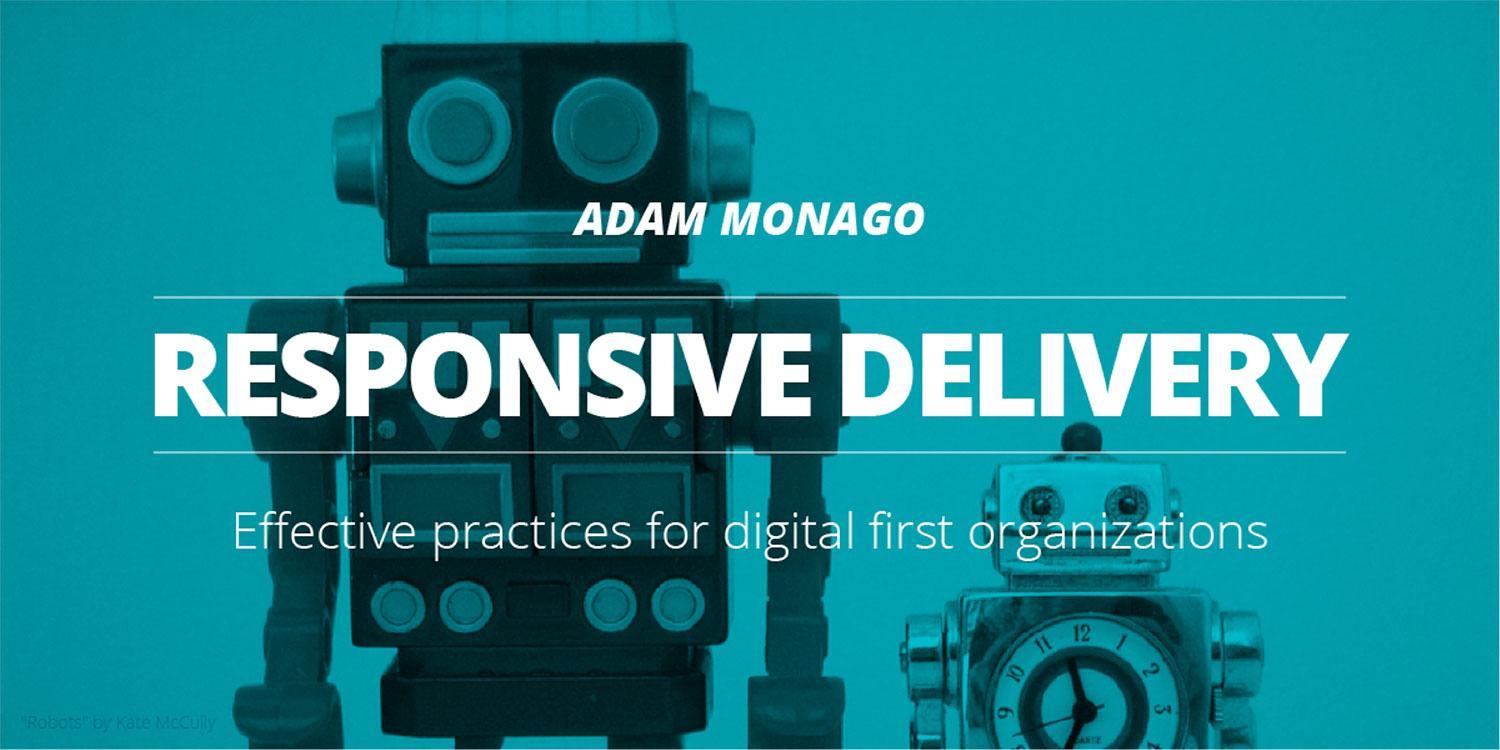
Defining the “Digital First” Organization
You will hear lots of definitions on what “digital first” means in the context of different organizations, typically oriented around the notion of a new type of consumer behavior. I describe “digital first” as focusing on content first, and then looking at how we can leverage that content across all available platforms, optimizing it for the behaviors and strengths native to those platforms. Understanding the significance of digital first requires an appreciation of the generational dynamics we are seeing today.
Brian Solis of Altimeter Group coined the term “Generation C” for the Connected Consumer to describe individuals who had crossed into a new lifestyle that is always connected to a broader ecosystem of friends, family and brands online. This group includes Generation “Y” and everyone after them, but also individuals from prior generations who have embraced the connected lifestyle.
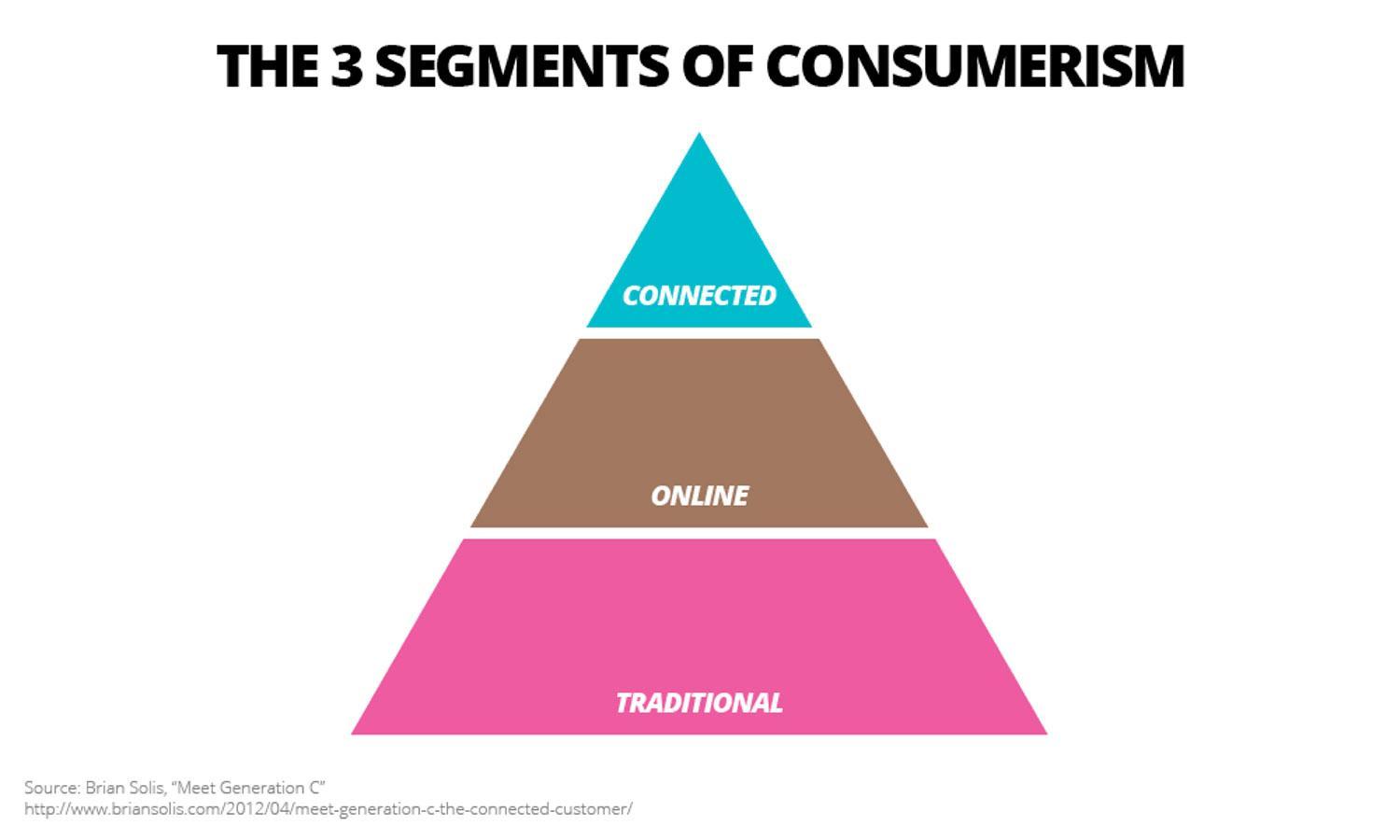
A deeper description of what characterizes Generation C can be found in a 2011 paper from Google, Winning The Zero Moment of Truth. The Zero Moment of Truth (ZMOT) is described as the instant that a consumer goes online to learn more about a product or service after receiving some stimulus in the marketplace. Google’s market research has revealed that often a stimulus is delivered on one connected device and the consumer’s response at the ZMOT happens on another.
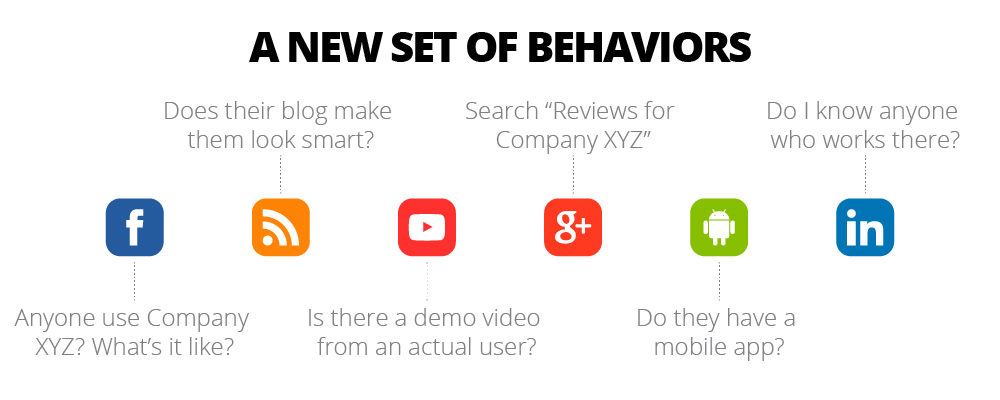
Here is the implication: whatever you are selling, you need to incorporate digital technologies (web, mobile, social) into your business model. Digital first companies are embracing this and are building (or tearing down and rebuilding) their services to embrace Generation C.
What is Responsive Delivery?
Your marketing and technology teams need to forge a joint delivery approach that is responsive to changing business needs.
The concept of Responsive Delivery is a bit of a play on the name of a popular philosophy of developing for the mobile web. This approach, dubbed responsive design, suggests that the application should be intelligent enough to detect the context in which it needs to render. That is, it should behave properly whether viewed on a desktop or on mobile.
Unfortunately, responsive design is not enough to solve the wider array of design challenges these enterprises are facing when delivering their content. You can follow this method and still have a strategy that is fundamentally adapting content written for a legacy medium. In the figure below, you can see just a few examples of the multitude of content, development and channel variations that make this challenging.
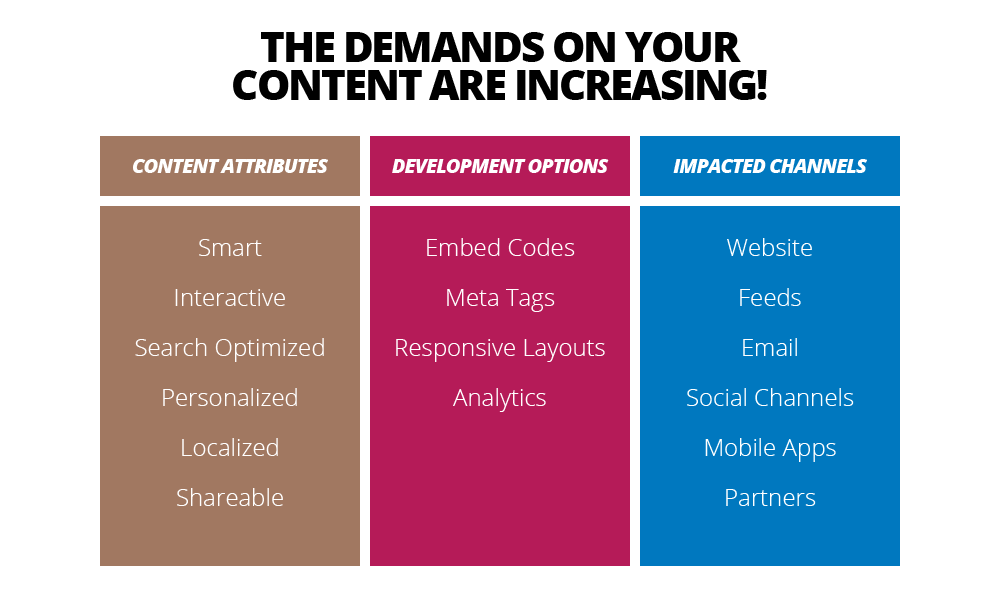
Examples of Digital First Organizations
The UK Government exemplifies a non-typical example of digital first. It has put a stake in the ground and said all services it provisions to the public will be digital by default; this has started with the launch of a new platform called GOV.UK. This platform will ultimately simplify the general public’s access to information, by putting their design needs first. More so, there is real cost savings for the UK government in allowing citizens to resolve their queries to completion digitally. The program leader, Mike Bracken, details some of the benefits of cutting the failure rate in this interview.
GOV.UK’s “Digital by Default” manual chronicles their journey and explains their design and delivery process. Some of the key characteristics include:
- Building and testing in small chunks
- Working quickly to deliver improvements to a service
- Teams will work out how to best meet the needs of users
- Releasing code regularly
- Working in an agile way
Publishing has been another field interesting to watch as it has examples of upstarts engineered to take advantage of the new models and veterans who are retooling their businesses to be digital first. Buzzfeed has revolutionized content and advertising through its data driven publishing model. Their CTO, Mark Wilkie says, “Getting things out…being as nimble as possible is the key…we want to get feedback from users and our systems early in the process.”
The New York Times, views Buzzfeed as the greatest threat to its business. In the NY Times Innovation report, they’ve actually looked deep into how they need to change the tools they provide to writers and editors to optimize, promote and analyze content far earlier in the development cycle.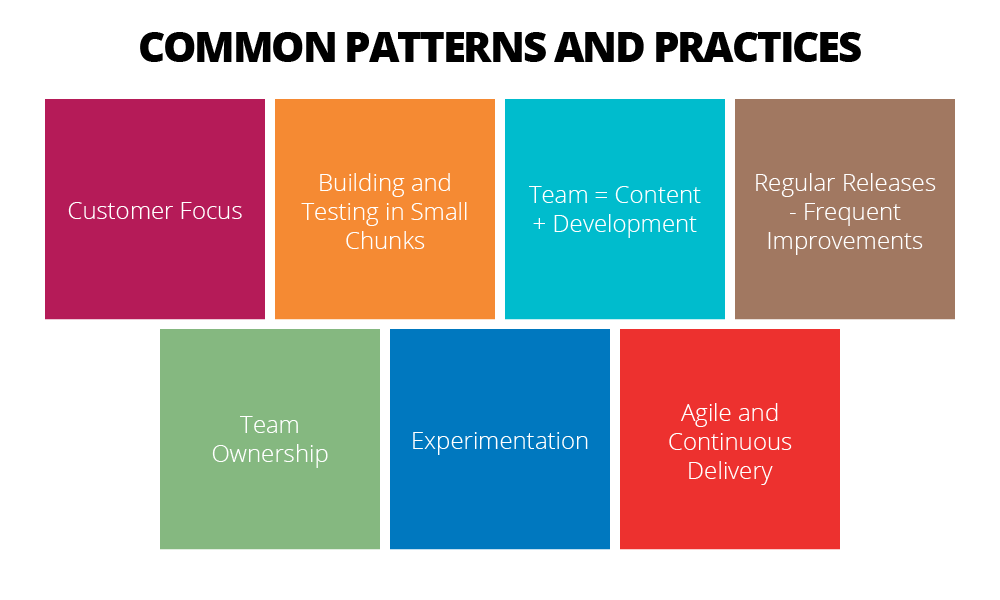
GOV.UK, Buzzfeed and the New York times, had a number of qualities in common. They share a set of common patterns and practices that help their marketing, creative and technology teams deliver awesome client experiences.
Marketers and Developers Need Each Other
Many of us are working within our organizations (or with clients) to create digital first experiences. More so, we are looking to craft rich customer experiences that increasingly rely on developers to deliver. Specifically, both groups are becoming more concerned with things such as:
- Personas
- Customer journeys
- Social
- Analytics
Working effectively together on these activities in a way that allows for fast and ongoing customer feedback, is what I mean by ‘Responsive Delivery’. Now let me tell you how to make responsive delivery a reality in your organization.
Four Key Components of Responsive Delivery
There are four ways that you can make responsive delivery a reality. These are:
- Building feedback into the development cycle
- Breaking down silos to create a collaborative work environment
- Collective team ownership of the solution
- Extensive automation
I’m drawing these insights from a development methodology called Continuous Delivery (CD). CD is one thing that the three organizations discussed thus far have in common.
CD is a movement that evolved from agile software development, Lean manufacturing, and Lean Start-Up to provide a way to describe the types of ecosystems that successful delivery organizations were creating. My former colleague Jez Humble, defines CD as "a set of principles and practices to reduce the cost, time, and risk of delivering incremental changes to users.”
The primary benefits of continuous delivery include, building functionality that really delivers the expected customer value and reducing the risk of release. We’ll apply similar principles and practices to content creation to hopefully derive similar benefits.
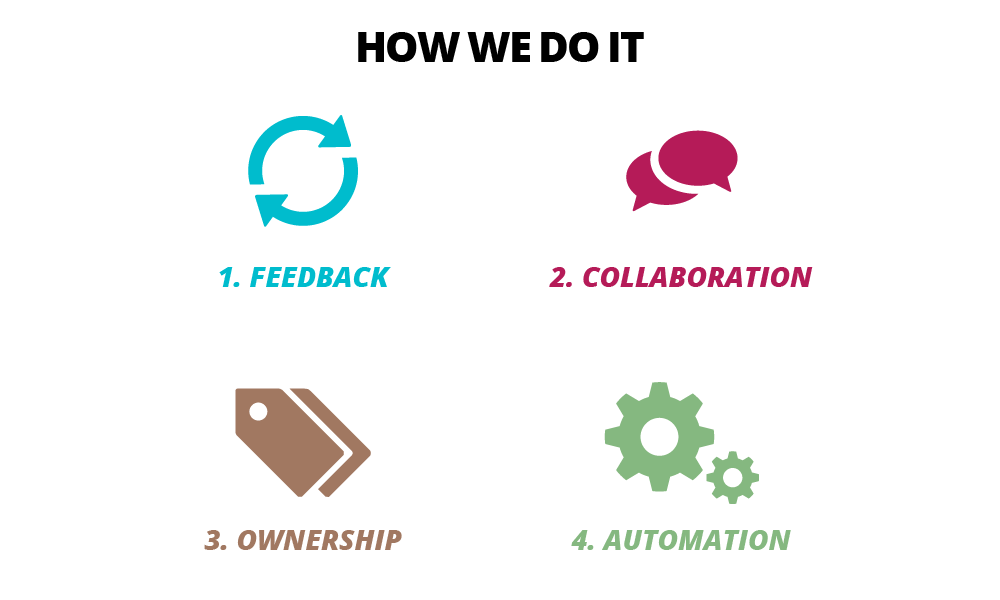
Build Feedback Into Your Development Cycle
The exact steps you follow may vary based on your organization and product, but the important thing is that they follow a cadence similar to the cycle described by Edward Deming. The 4 steps in the Deming Cycle are: Plan-Do-Check-Act (PDCA). The “Act” is often the most difficult for people to grasp – this is the notion that after validating our work we reflect on how we can improve with each iteration. This idea of ‘continuous improvement’ is called Kaizen and originated in the Lean Manufacturing movement.
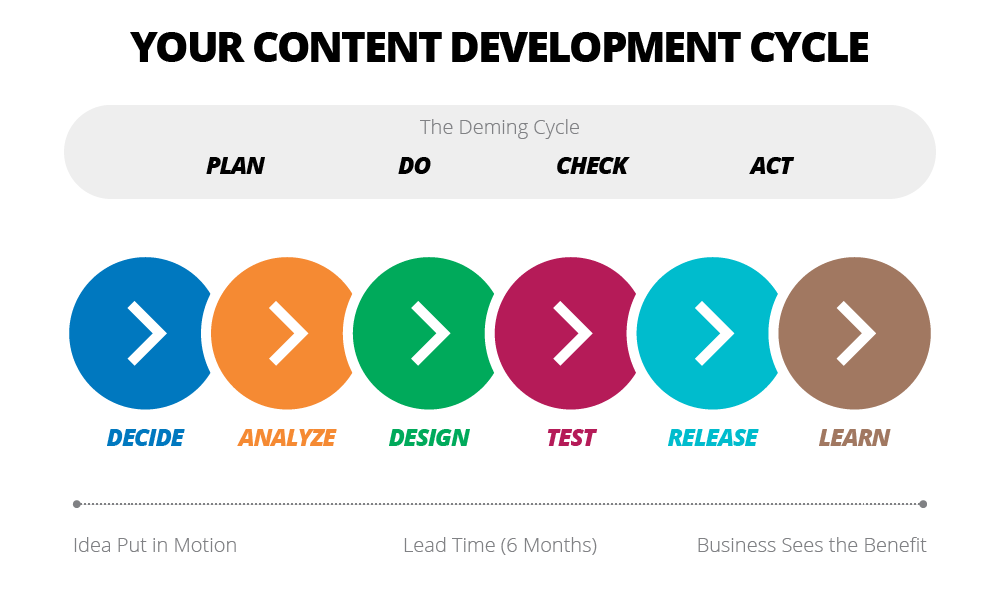
With each cycle, it is expected that you learn more and build upon the previous iteration. Consider your ‘lead time’ as the time elapsed between when you decide to do a piece of work and when you recoup that learning as a business. By looking to continuously improve that lead time, you can reduce the amount of time it takes to get feedback to the team doing the work. If you are optimizing your process only to ‘release’, you’ll get quantity, not quality.
One of the true tests of whether you have achieved CD is whether the business owner for the project can decide to deploy the software at any given time. This suggests another dimension or practice into our CD repertoire: the need to structure our ‘requirements’ or features to be minimum viable. For a complete definition of the term, review the Wikipedia entry for Minimum Viable Product (MVP). The notion of MVP is something that has resonated with a number of modern methodologies including the Lean Startup and Lean Product Development.
“Build the right thing” is a euphemism for the cost of change; it means that wasteful costs can be prevented first by deciding what is really essential for the business and doing just enough.
Here is an example that might resonate with those of you who focus on conversion rate optimization initiatives, from an article written by my colleague Jenny Wong. Imagine you are working with business partners to allow users to sign up for an online magazine subscription. The scope includes these parts:
Feature: Allow subscribers to sign up for a Weekly or Monthly Subscription
- Send weekly-aggregated content to subscribers
- Send monthly digest to subscribers
- Get subscriber contact and payment information
- Confirm order via email
- Analytics
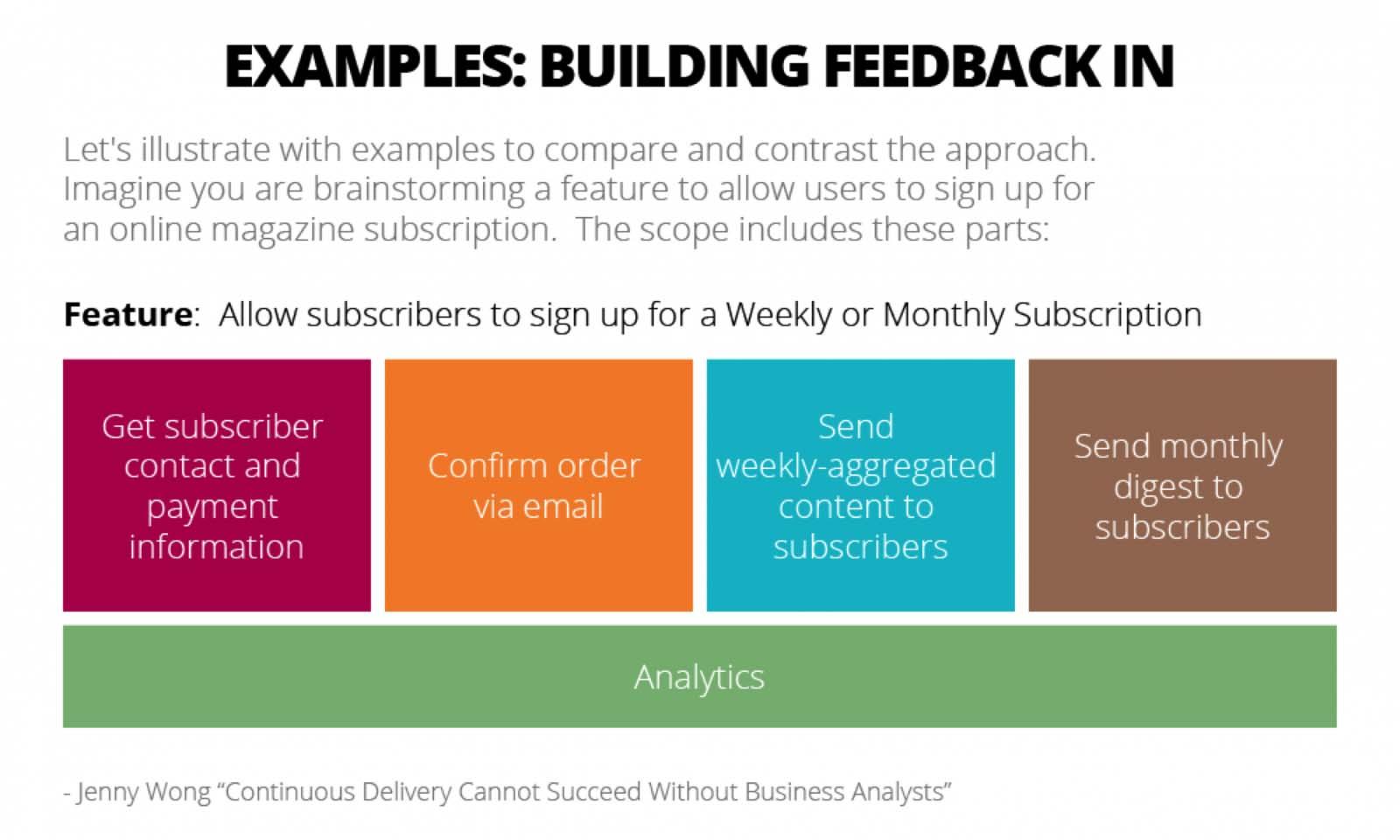
The first example shows what many teams might normally do: choose to deliver the weekly content first. You also find that you would need to curate the monthly version before it can go out to subscribers. So you might plan to develop your feature in two release increments.
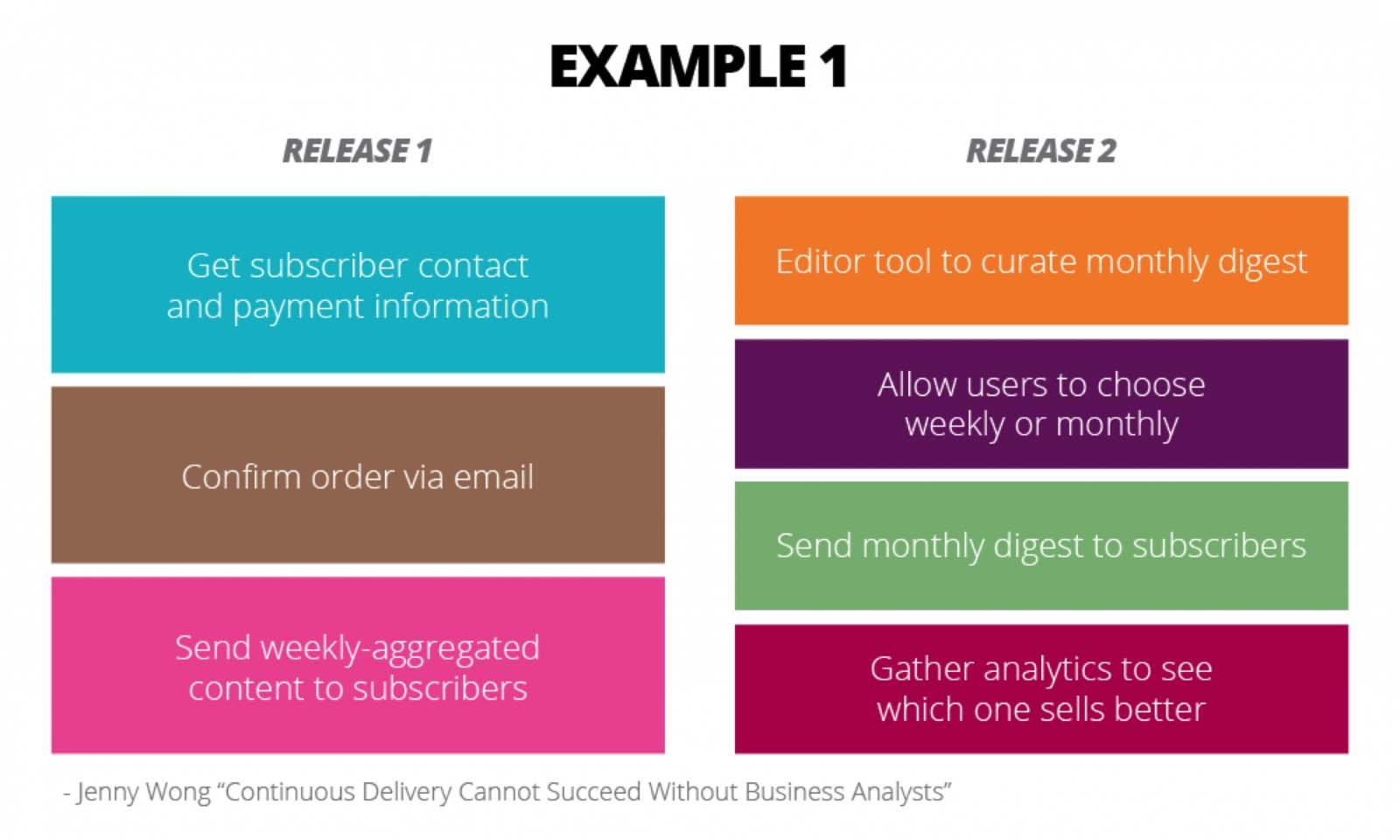
The first release gives your subscribers a weekly subscription and process payment; the second release allows you to enhance the service by selling another product, as well as adding a feedback mechanism. In this case, you are still assuming that you plan to build the monthly digest part, and then get some feedback to learn about how well you did afterwards.
In the second example, we rearrange the work so you can get feedback sooner. Same context, but consider the following:
As of the first release, you have not committed to build the weekly or the monthly version yet, or indeed to build one at all. You are testing to validate what your customers prefer before investing the resources to develop. At this point, you have no other requirements sitting idle in your backlog either because you just do not know what the outcome would be; your next step will be determined by what the analytics tell you. At the end of the time-box, you find that most subscribers prefer a weekly subscription. So you plan out the next release like this:
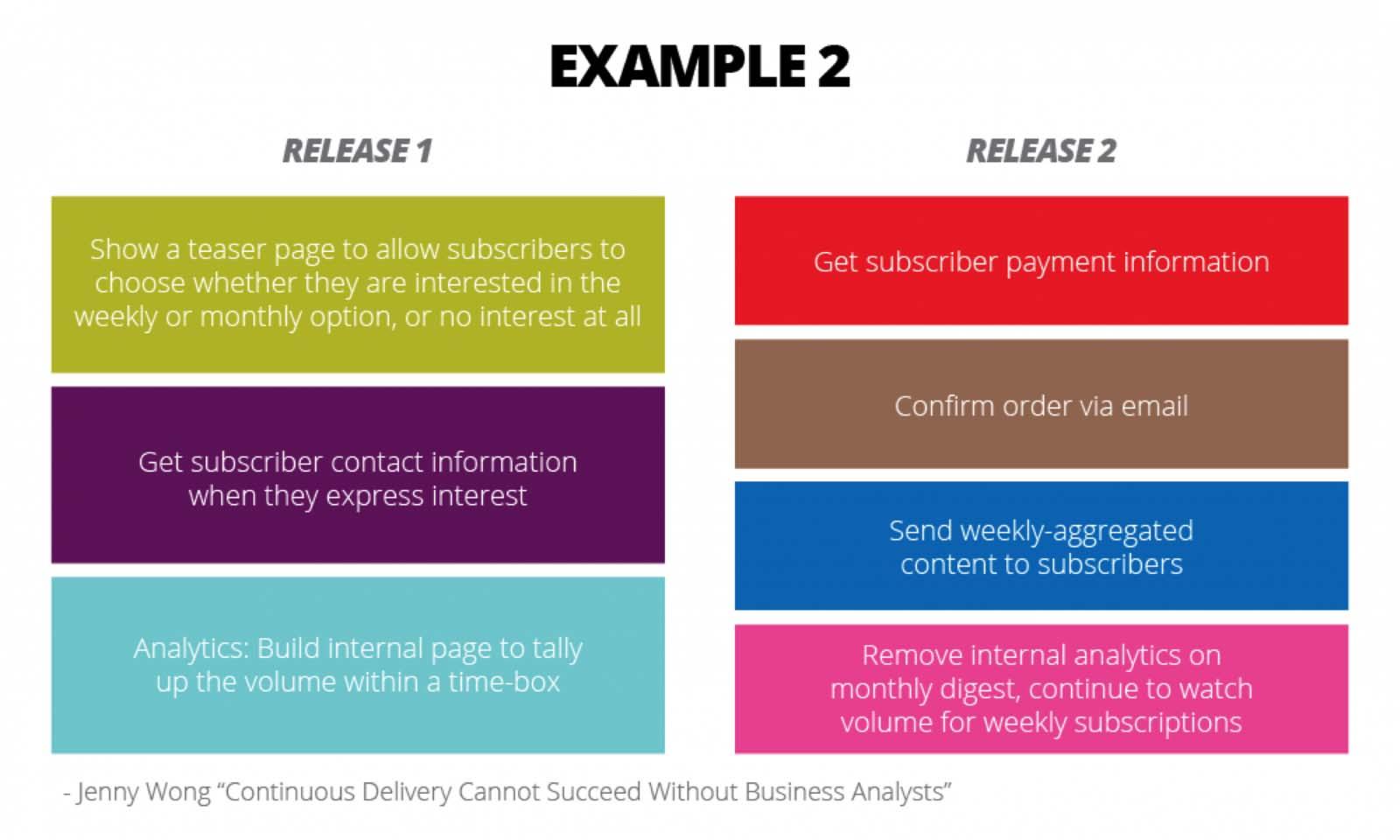
As of the second release, notice that you have completely discarded the idea of building an editor tool to curate the content for a monthly digest (from Example 1), and there is no need to scrap the now-obsolete set of requirements to do with the monthly digest. These are your saved costs - the financial costs of building something that you do not need, and the opportunity cost of using the time in delivering something much more useful to the market.
This helps eliminate the challenge of having too many variables in play during a release. Conversion rate optimization (CRO) practitioners really want to know the impact of their experiments.
Breaking Down Functional Silos
A responsive delivery organization requires a collaborative working relationship between everyone involved in delivery. I will focus primarily on organizational design and secondarily on colocation aspects of collaboration.
If we want to optimize for business value – for the work that has to happen – we need to get everyone involved in delivering that value together, so that they can have fast feedback cycles in refining the product. Unfortunately, many of us do not work in companies where we are organized that way. We are organized in departmental silos.
Conway's Law is an adage named after computer programmer Melvin Conway, who introduced the idea in 1968. It states that organizations which design systems ... are constrained to produce designs which are copies of the communication structures of these organizations. My colleague Sam Newman discusses Conway’s Law in more depth here.
It’s important to state Conway’s Law here because until we organize marketers and developers together, they will continue to optimize work to make their department look successful, rather than to satisfy the needs of their clients.
The global career marketplace, Seek, restructured their organization to suit the continuous delivery cycle. Marketers and recruiters involved in campaign design and process optimization are organized on product teams with product people, designers and developers. They’ve developed a cadence of organizational rotation that puts those individuals on teams for a minimum of one year!
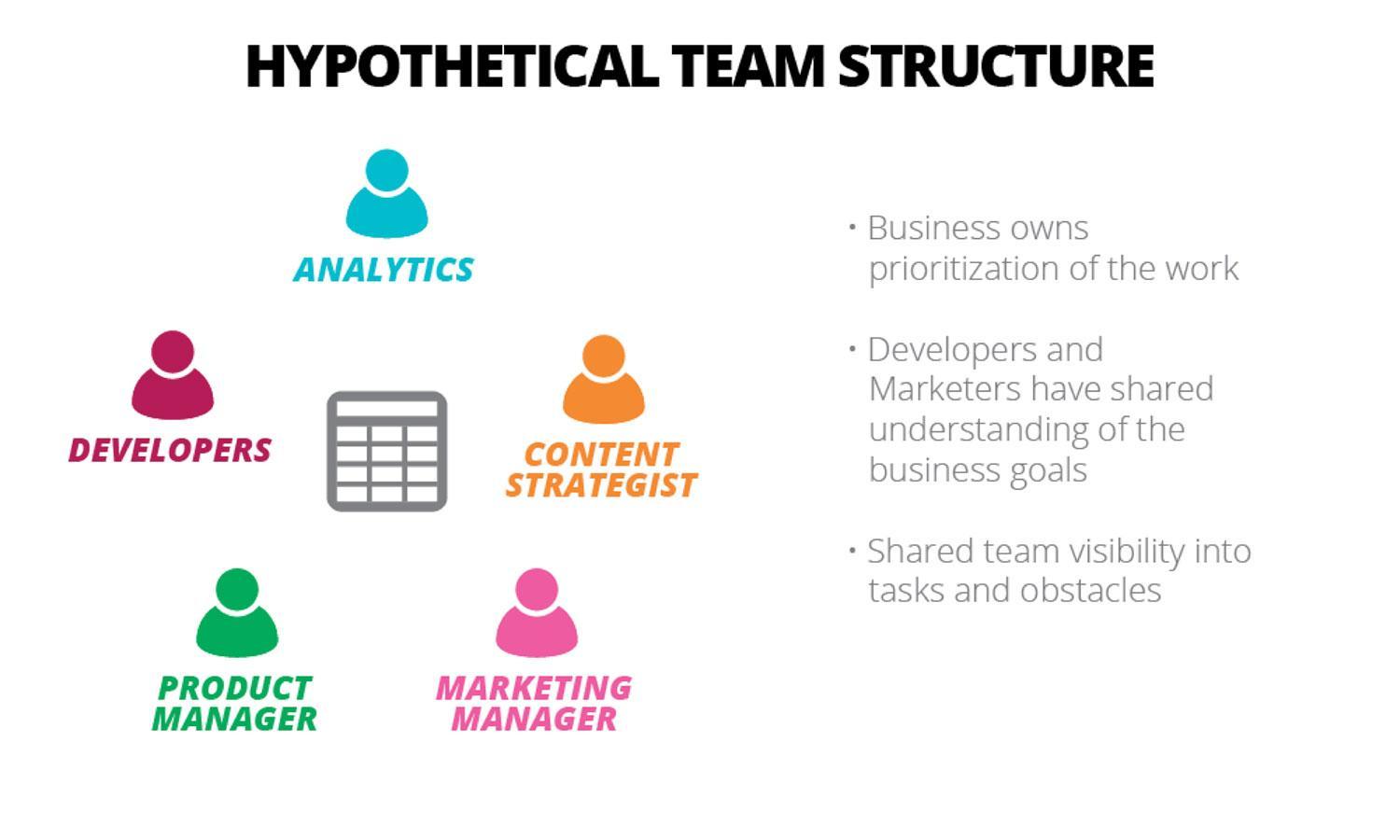
Getting started with this does not have to be complicated or scary. Use these guidelines:
- Work with your IT colleagues to pick a small pilot project that’s relevant, but also not the most sensitive.
- Set the expectation that the ‘best practices’ and ‘failures’ from this effort will be shared with other teams.
- Build time in to regularly look back on how it is going, and what you could be doing better to support these groups. Use these tips for conducting an effective retrospective.
- Work with your leaders to set the tone that small failures that happen early and allow us to learn from them are better than big failures that happen later when it is too late to correct.
Collective Team Ownership
In all of the examples of Digital First organizations that I have noted noted, there was an intentional push towards more autonomy and ownership by the people closest to the work. This is based on a management theory originally presented by Donald Reinertsen.
Reinertsen in his “Principles of Product Development Flow” talks about something called the Principle of Mission. One of the primary thrusts of this is that it is the responsibility of managers and leaders to continuously revision the mission and vision of a project and delegate the ‘how we’re going to get there’ to their team.
Some of the ways we check that this is happening are:
- Through frequent feedback on the effect of their actions on the overall business goals. This can be measured by tracking things such as subscriptions, product trials or sales inquiries.
- By working in small batches. This can be measured by tracking the number of campaigns we run at the same time, lead time, and the number of experiments run.
- By continually adjusting and correcting our approach based on the learning we accumulate throughout the process. This can be validated through customer surveys, improvement in other KPIs and team retrospectives.
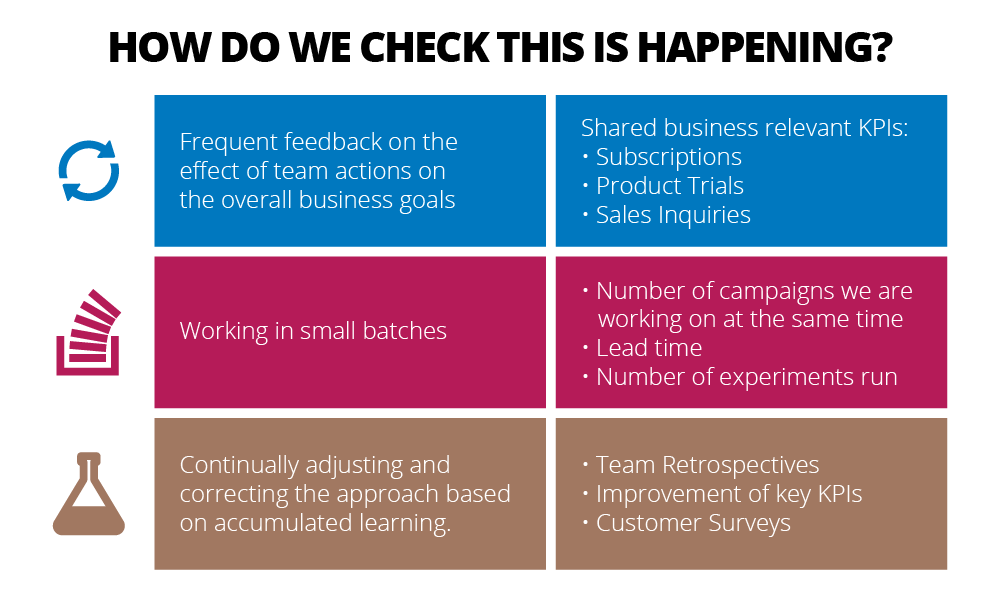
Automation
Thoughtworker Neal Ford has a joke: “When humans do the things that computers could be doing instead, all the computers get together late at night and laugh at us.”
The initial writings on continuous delivery, describe how a team can through extensive automation, ensure that software itself is always ready to release. I also contend that great online marketers also have a collection of time-savings methods to allow themselves to be more responsive to timelines and shifting requirements. Frameworks, templates and checklists can be put in place to speed creation of campaigns based on past successes.
Following, we’ll talk about a number of techniques you can use to streamline your online campaigns.
- Feature Toggles
- Video Production Process
- Leverage Content Pillars
- Designing for Robots
Feature Toggles
Mike Britain of Etsy talks about how they use a technique called configuration flags to safely toggle new capabilities on and off in production in order to allow for new functionality to be released but not seen by users until it is ready. This capability also allows for close testing and monitoring of these features when rolled out on the heavily trafficked site. Feature Toggles have also been written about by Martin Fowler on his website.
Automate Your Video Production Process
If you are involved in content production, you may have experienced how expensive and time-consuming it can be to make one video for your business. Checklists and well defined process can be the building blocks for awesome productions. Once you have all of the physical and design assets created, the investment in further content decreases dramatically.
Moz’s Whiteboard Friday is a great example of a cornerstone piece of content for their online experience that was built through ongoing refinement of the method. You can read more about its evolution in a great story on the Wistia blog.
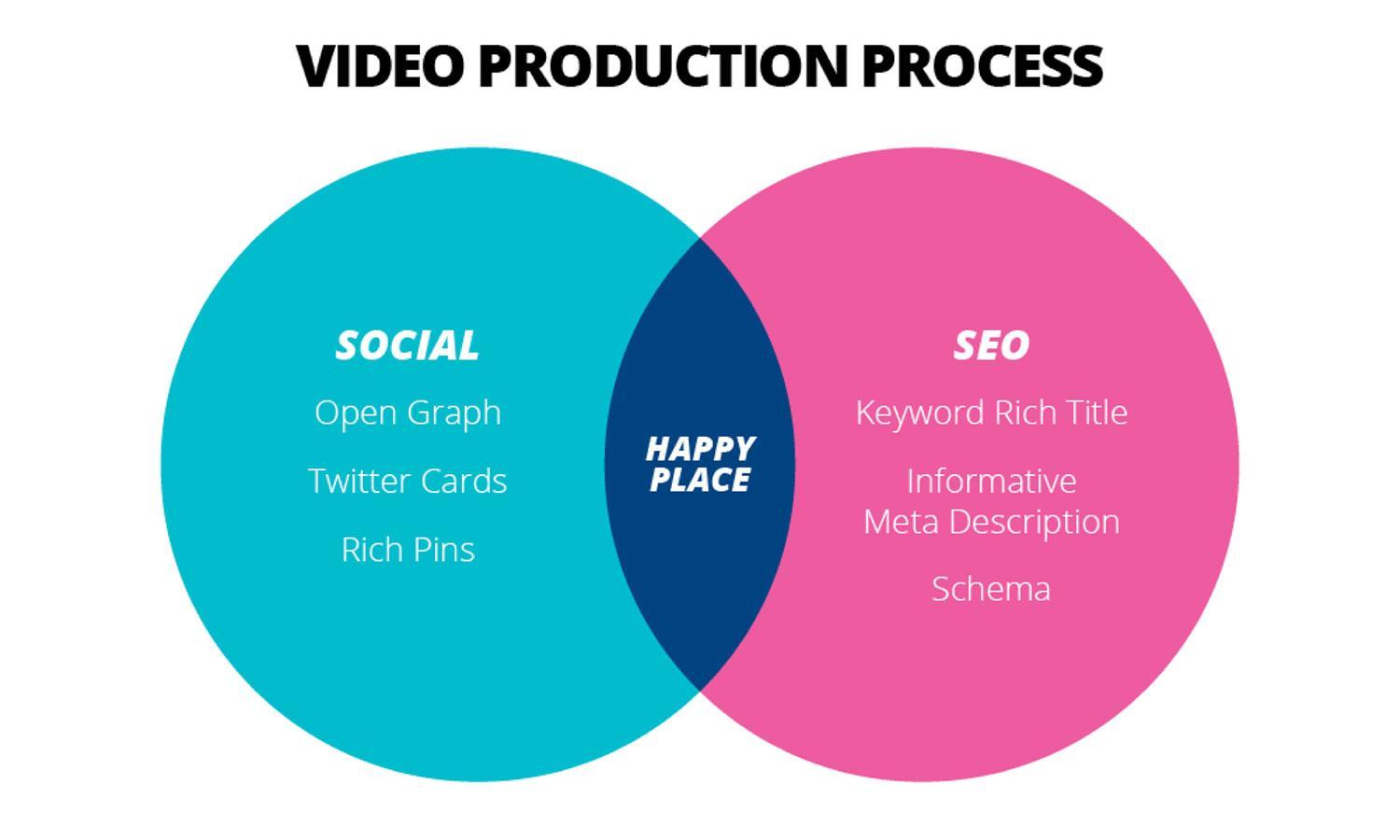
Leverage Content Pillars
One of the major advantages of developing larger content pieces, is that you can leverage them across multiple channels and formats by breaking them up into smaller pieces. This is a good idea if you do not want your ‘big idea’ to be missed by visitors who perhaps come in through a different channel or who have not warmed up enough to your brand yet to digest the full piece.
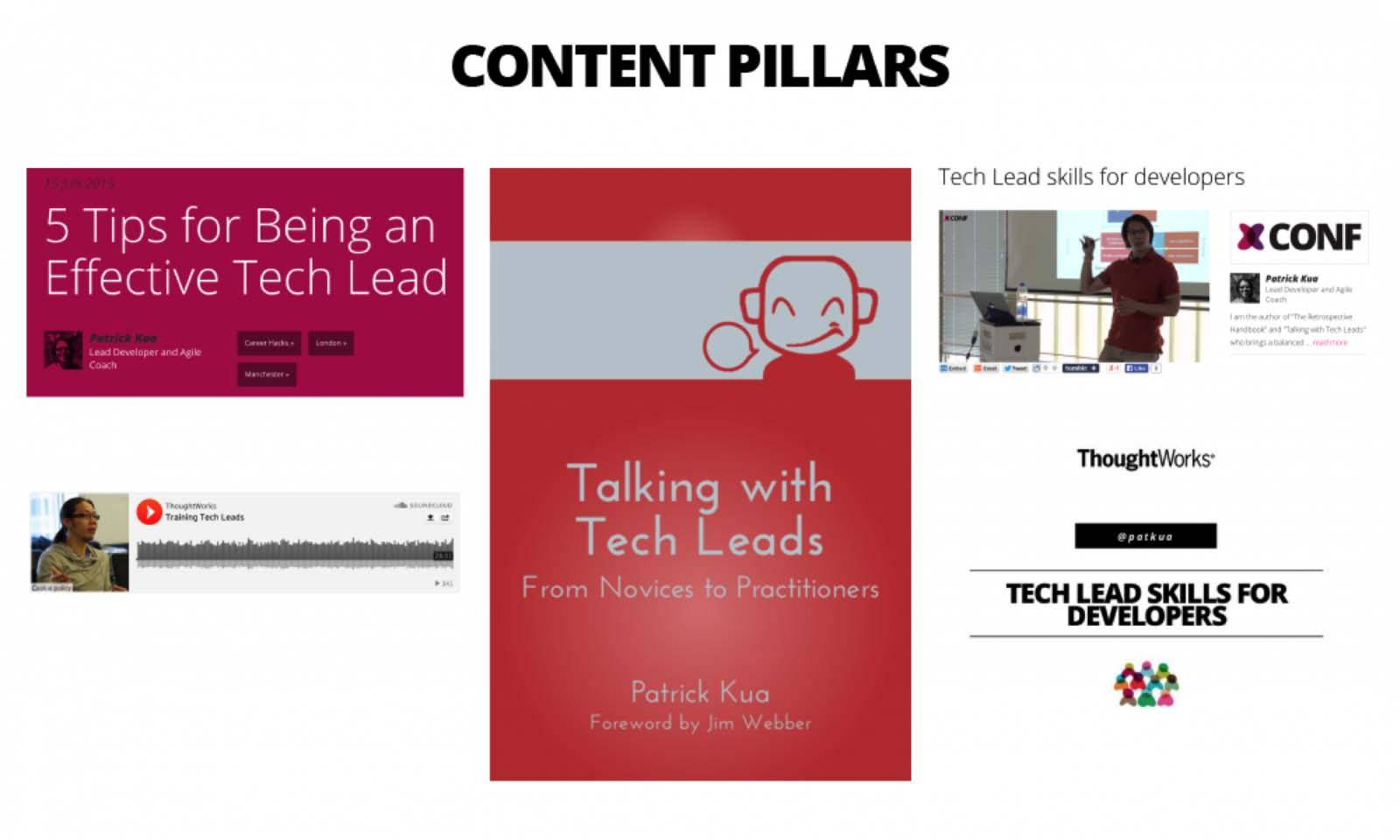
So that one, monumental eBook might actually help our team build out its calendar by providing the meat for several blog posts, multiple Slideshares or even some video content. A great example of a content pillar from Thoughtworks is Patrick Kua, who recently published a great book called “Talking With Tech Leads”. As the book addresses a number of important themes for lead developers, it provided a great launchpad to other content suited to the tastes of different readers, including blogs, podcasts, and more.
Design for Robots
Publishing on social media and email today means that you need to optimize your content to perform its best on them, just as you would with search. This is because the main social channels are counting on your meta data to tell it how you want your titles to appear and what are the best images to showcase in your posts.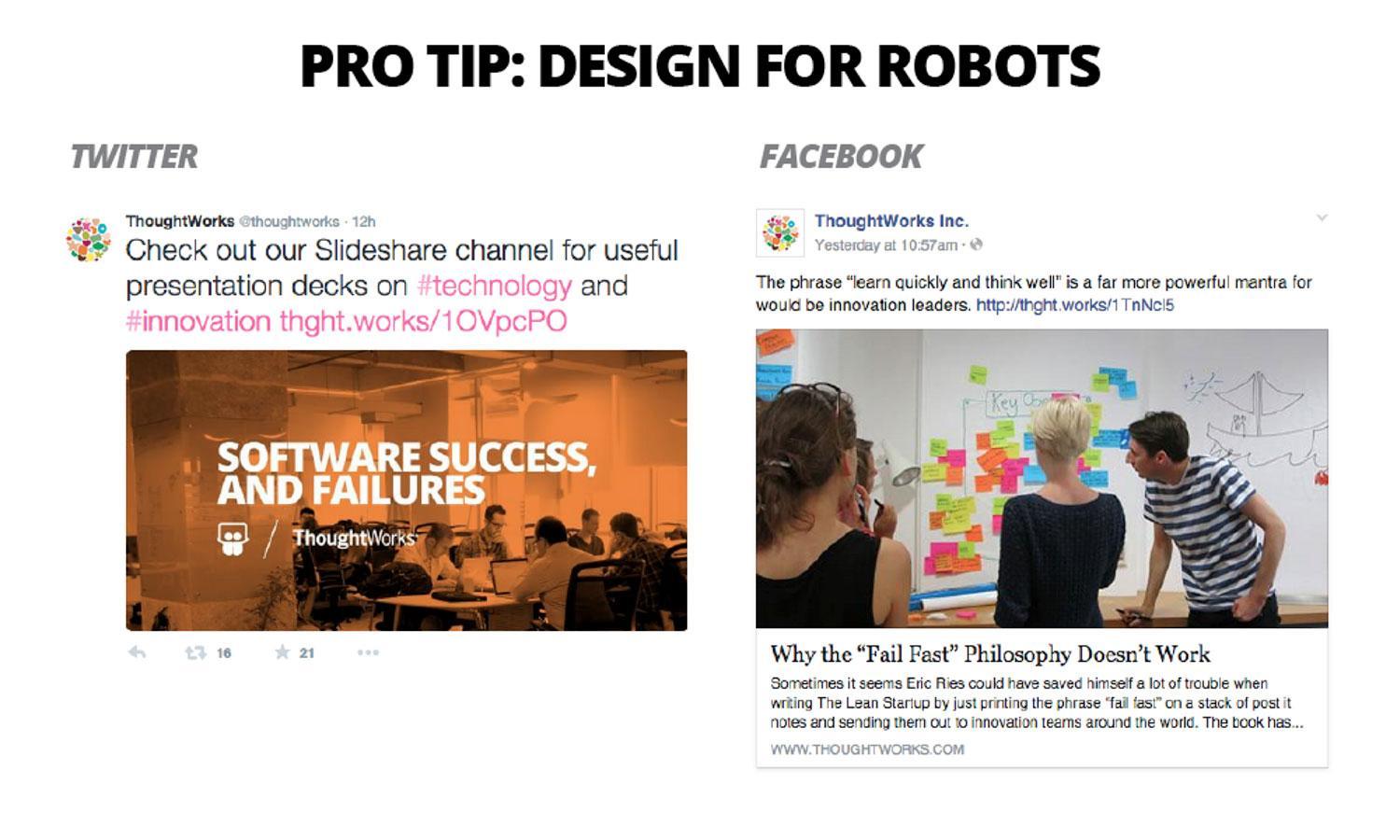
Take the time to generate quality meta-tags and images for your posts, and stay tuned-in to updates from the major networks on how to make the most of their platform. You should also make sure you don’t limit yourself to twitter and Facebook cards. For example, Gmail recently has been testing custom art on its new promotions tab card layout.
While we have discussed a number of areas where automation works, it is important to keep the human touch where it is needed most – close to the customer. Social media listening and response is a great example of this; you may be familiar with the Bank of America twitter bot fiasco.
Disclaimer: The statements and opinions expressed in this article are those of the author(s) and do not necessarily reflect the positions of Thoughtworks.














